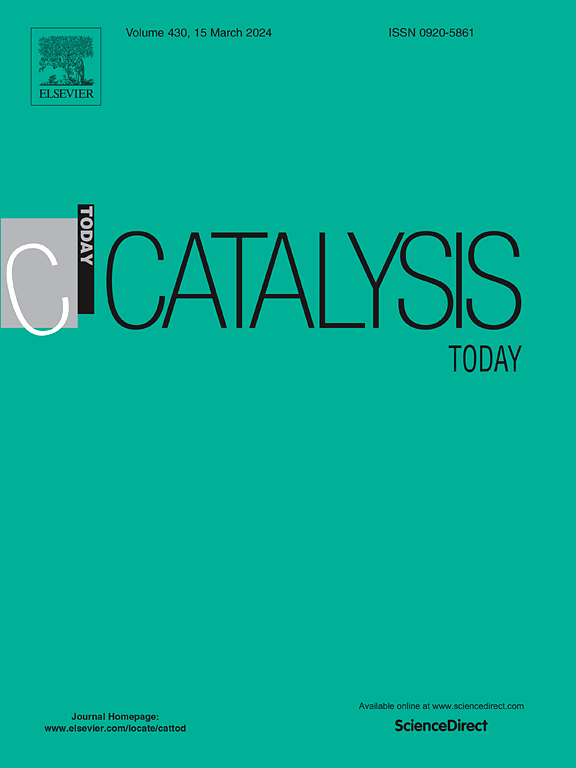Cu-doped TiO2 porous discs: A novel photo-enzyme catalyst for enhanced antibacterial activity and oral ulcer treatment
IF 5.2
2区 化学
Q1 CHEMISTRY, APPLIED
引用次数: 0
Abstract
The global challenge of bacterial infections and antibiotic resistance underscores the urgent need for innovative antimicrobial strategies, with emerging photodynamic therapy using photocatalysts and nanozyme technologies showing promise in addressing multidrug-resistant pathogens. However, limited research exists on synergistic systems integrating both photocatalysts and nanoenzymes, highlighting a vital gap requiring systematic exploration. This study addresses this void through the rational design of copper-doped titanium dioxide (Cu-TiO2) porous disc catalysts that synergistically combine photocatalytic activity with light-activated enzymatic activity. The optimized Cu doping strategy substantially improved charge separation efficiency and redox capacity, while the hierarchical porous architecture maximized reactive oxygen species (ROS) generation through exposing of abundant active sites and enhancing mass transport of reactants. Under Xe light irradiation, the engineered Cu-TiO2 demonstrated exceptional antimicrobial efficacy, achieving 99.7 % eradication of ampicillin-resistant Escherichia coli (AREC) within 45 minutes and 97.5 % elimination of methicillin-resistant Staphylococcus aureus (MRSA) within 60 minutes. Notably, the integration with low-concentration H2O2 under illumination activated photo-enhanced peroxidase-mimicking activity, enabling 99.3 % MRSA inactivation within 30 minutes. Practical validation through hydrogel-mediated treatment of oral ulcer infections confirmed accelerated wound healing and infection control. This bifunctional catalysts establishes a new paradigm for developing light-responsive antimicrobial agents, offering transformative potential for combating antibiotic-resistant infections in biomedical and environmental applications through ROS-mediated multimodal disinfection mechanisms.
cu掺杂TiO2多孔片:一种增强抗菌活性和治疗口腔溃疡的新型光酶催化剂
细菌感染和抗生素耐药性的全球挑战强调了对创新抗菌策略的迫切需要,使用光催化剂和纳米酶技术的新兴光动力疗法在解决多重耐药病原体方面显示出希望。然而,整合光催化剂和纳米酶的协同系统的研究有限,突出了一个需要系统探索的重要空白。本研究通过合理设计铜掺杂二氧化钛(Cu-TiO2)多孔圆盘催化剂,将光催化活性和光活化酶活性协同结合,解决了这一空白。优化后的Cu掺杂策略大大提高了电荷分离效率和氧化还原能力,而分层多孔结构通过暴露丰富的活性位点和增强反应物的质量传递,最大限度地提高了活性氧(ROS)的生成。在Xe光照射下,工程Cu-TiO2表现出优异的抗菌效果,在45 分钟内对氨苄西林耐药大肠杆菌(AREC)的根除率达到99.7% %,在60 分钟内对耐甲氧西林金黄色葡萄球菌(MRSA)的根除率达到97.5% %。值得注意的是,在光照下与低浓度H2O2的结合激活了光增强的过氧化物酶模拟活性,在30 分钟内使99.3% %的MRSA失活。实际验证通过水凝胶介导治疗口腔溃疡感染证实加速伤口愈合和感染控制。这种双功能催化剂为开发光响应抗菌剂建立了新的范例,通过ros介导的多模态消毒机制,为生物医学和环境应用中对抗抗生素耐药感染提供了变革潜力。
本文章由计算机程序翻译,如有差异,请以英文原文为准。
求助全文
约1分钟内获得全文
求助全文
来源期刊

Catalysis Today
化学-工程:化工
CiteScore
11.50
自引率
3.80%
发文量
573
审稿时长
2.9 months
期刊介绍:
Catalysis Today focuses on the rapid publication of original invited papers devoted to currently important topics in catalysis and related subjects. The journal only publishes special issues (Proposing a Catalysis Today Special Issue), each of which is supervised by Guest Editors who recruit individual papers and oversee the peer review process. Catalysis Today offers researchers in the field of catalysis in-depth overviews of topical issues.
Both fundamental and applied aspects of catalysis are covered. Subjects such as catalysis of immobilized organometallic and biocatalytic systems are welcome. Subjects related to catalysis such as experimental techniques, adsorption, process technology, synthesis, in situ characterization, computational, theoretical modeling, imaging and others are included if there is a clear relationship to catalysis.
 求助内容:
求助内容: 应助结果提醒方式:
应助结果提醒方式:


